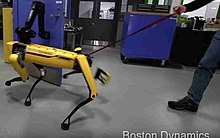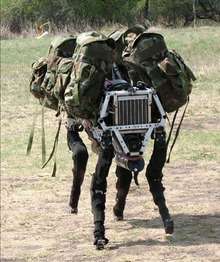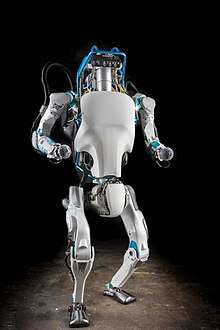Boston Dynamics
 | |
| Industry | Robotics |
|---|---|
| Founded | 1992 |
| Founder | Marc Raibert |
| Headquarters | |
Key people | Marc Raibert (Chief executive officer) |
| Owner |
SoftBank Group (2017-), Google X (2013 - 2017) |
| Parent | SoftBank |
| Website |
www |
Boston Dynamics is an American engineering and robotics design company founded in 1992 as a spin-off from the Massachusetts Institute of Technology. Headquartered in Waltham, Massachusetts, Boston Dynamics is a wholly owned subsidiary of the Japanese conglomerate SoftBank Group.
Boston Dynamics is best known for the development of BigDog, a quadruped robot designed for the U.S. military with funding from Defense Advanced Research Projects Agency (DARPA),[1][2] and DI-Guy, software for realistic human simulation. Early in the company's history, it worked with the American Systems Corporation under a contract from the Naval Air Warfare Center Training Systems Division (NAWCTSD) to replace naval training videos for aircraft launch operations with interactive 3D computer simulations featuring DI-Guy characters.[3] The company is a pioneer in the field of robotics and it is one of the most advanced in its domain.[4][5][6][7] Marc Raibert is the company's president and project manager. He spun the company off from the Massachusetts Institute of Technology in 1992.
On 13 December 2013, the company was acquired by Google X (later X, a subsidiary of Alphabet Inc.) for an unknown price,[8] where it was managed by Andy Rubin until his departure from Google in 2014.[9] Immediately before the acquisition, Boston Dynamics transferred their DI-Guy software product line to VT MÄK, a simulation software vendor based in Cambridge, Massachusetts.[10] On 8 June 2017, Alphabet Inc. announced the sale of the company to Japan's SoftBank Group for an undisclosed sum.[11]
Products
BigDog
BigDog was a quadrupedal robot created in 2005 by Boston Dynamics, in conjunction with Foster-Miller, the Jet Propulsion Laboratory, and the Harvard University Concord Field Station. It was funded by the DARPA in the hopes that it would be able to serve as a robotic pack mule to accompany soldiers in terrain too rough for vehicles, but the project was shelved after BigDog was deemed too loud to be used in combat.[12][13] Instead of wheels, BigDog used four legs for movement, allowing it to move across surfaces that would defeat wheels. Called "the world's most ambitious legged robot", it was designed to carry 340 pounds (150 kg) alongside a soldier at 4 miles per hour (6.4 km/h; 1.8 m/s), traversing rough terrain at inclines up to 35 degrees.
Cheetah
The Cheetah is a four-footed robot that gallops at 28 miles per hour (45 km/h; 13 m/s), which as of August 2012 is a land speed record for legged robots.[14] By 2018 the robot was able to climb stairs.[15]
A similar but independently developed robot also known as Cheetah is made by MIT's Biomimetic Robotics Lab,[16] which, by 2014, could jump over obstacles while running.[17][18]
LittleDog
LittleDog is a small quadruped robot developed for DARPA by Boston Dynamics for research. Unlike BigDog, which is run by Boston Dynamics, LittleDog is intended as a testbed for other institutions. Boston Dynamics maintains the robots for DARPA as a standard platform.[19]
LittleDog has four legs, each powered by three electric motors. The legs have a large range of motion. The robot is strong enough for climbing and dynamic locomotion gaits. The onboard PC-level computer does sensing, actuator control and communications. LittleDog's sensors measure joint angles, motor currents, body orientation and foot/ground contact. Control programs access the robot through the Boston Dynamics Robot API. Onboard lithium polymer batteries allow for 30 minutes of continuous operation without recharging. Wireless communications and data logging support remote operation and data analysis. LittleDog development is funded by the DARPA Information Processing Technology Office.<
PETMAN
PETMAN (Protection Ensemble Test Mannequin) is a bipedal device constructed for testing chemical protection suits. It is the first anthropomorphic robot that moves dynamically like a real person.[20]
LS3
Legged Squad Support System (LS3), also known as AlphaDog, is a militarized version of BigDog. It is ruggedized for military use, with the ability to operate in hot, cold, wet, and dirty environments.
Atlas
The Agile Anthropomorphic Robot "Atlas" is a 6-foot (183 cm) bipedal humanoid robot, based on Boston Dynamics' earlier PETMAN humanoid robot, and designed for a variety of search and rescue tasks.
In February 2016 Boston Dynamics published a YouTube video entitled "Atlas, The Next Generation" showing a new humanoid robot about 5' 9" tall (175 cm, about a head shorter than the original DRC Atlas). In the video, the robot is shown performing a number of tasks that would have been difficult or impossible for the previous generation of humanoid robots.[21]
SpotMini

On June 23, 2016, Boston Dynamics revealed the four-legged canine-inspired SpotMini which only weighs 25 kg (55 pounds) and is lighter than their other products.[22]
In February 2018, a promotional video of the SpotMini using its forward claw to open a door for another robot reached #1 on YouTube, with over 2 million views. A later video the same month showed the SpotMini persisting in attempting to open the door in the face of human interference. Viewers perceived the robot as "creepy" and "reminiscent of all kinds of sci-fi robots that wouldn't give up in their missions to seek and destroy".[23][24][25]
On May 11, 2018 CEO of Boston Dynamics Marc Raibert on TechCrunch Robotics Session 2018 announced that SpotMini robot is in pre-production and preparing for commercial availability in 2019. [26] On its website, Boston Dynamics highlights that SpotMini is the “quietest robot [they] have built.” The company says it has plans with contract manufacturers to build the first 100 SpotMinis later this year[27] for commercial purposes, with them starting to scale production with the goal of selling SpotMini in 2019.
Handle
Handle is a research robot that stands 6.5 ft (198 cm) tall, travels at 9 mph (14.5 km/h) and jumps 4 feet (122 cm) vertically. It uses electric power to operate both electric and hydraulic actuators, with a range of about 15 miles (24 km) on one battery charge. Handle uses many of the same dynamics, balance and mobile manipulation principles found in the quadruped and biped robots Boston Dynamics builds, but with only about 10 actuated joints, it is significantly less complex.[28]
References
- ↑ David Hambling, Robotic 'pack mule' displays stunning reflexes, New Scientist, 3 March 2006.
- ↑ Madrick, Jeff; Madrick, Jeff (24 April 2014). "Innovation: The Government Was Crucial After All" – via The New York Review of Books.
- ↑ Sharon Foster, "Updating Technology Without Upping the Price: Boston Dynamics completes first phase of catapult trainer upgrade", (subscription required), National Defense, November 1, 2001.
- ↑ "Here are all the crazy-advanced robots built by Google's Boston Dynamics group".
- ↑ 90210, HAL (15 August 2017). "Robot shelf-stack fail suggests they won't take our jobs just yet" – via www.theguardian.com.
- ↑ Staff, RT. "Boston Dynamics - Robotics Trends". www.roboticstrends.com.
- ↑ Liszewski, Andrew. "ATLAS: Probably the Most Advanced Humanoid Yet, Definitely Terrifying".
- ↑ "Google is trying to sell Boston Dynamics, the crazy robotics company it bought in 2013".
- ↑ "Google Adds to Its Menagerie of Robots", New York Times, December 14, 2013.
- ↑ "DI-Guy Now Part of VT MÄK", Military Simulation and Training Magazine, December 11, 2013.
- ↑ Lunden, Ingrid. "SoftBank is buying robotics firms Boston Dynamics and Schaft from Alphabet - TechCrunch".
- ↑ Degeler, Andrii. "Marines' LS3 robotic mule is too loud for real-world combat". Ars Technica. Retrieved 2 January 2016.
- ↑ Markoff, John (9 April 2012). "Pentagon Contest to Develop Robots to Work in Disaster Areas". The New York Times.
- ↑ Goddard, Louis (September 6, 2012). "Cheetah robot sets 28.3 mph speed record, outrunning Usain Bolt". The Verge.
- ↑ Becker, Rachel (July 5, 2018). "MIT's Cheetah 3 robot can run up stairs without watching its steps". The Verge.
- ↑ "MIT Cheetah Robot Runs Fast, and Efficiently". IEEE Spectrum: Technology, Engineering, and Science News.
- ↑ Biomimetics MIT (14 September 2014). "MIT Cheetah robot 2 running fast and jump over an obstacle" – via YouTube.
- ↑ "MIT reveals how its military-funded Cheetah robot can now jump over obstacles on its own".
- ↑ Greenemeier, Larry "DARPA Pushes Machine Learning with Legged LittleDog Robot", Scientific American, April 15, 2008
- ↑ "PETMAN (Protection Ensemble Test Mannequin) Humanoid Military Robot". Army Technology. 2011-06-15. Retrieved 2013-12-17.
- ↑ "Google human-like robot brushes off beating by puny human – this is how Skynet starts". The Register. 24 Feb 2016. Retrieved 3 Jun 2016.
- ↑ "Boston Dynamic's released Spot Mini".
- ↑ Ferris, Robert (13 February 2018). "Boston Dynamics' robot dog that opens doors is freaking out the internet". CNBC. Retrieved 26 February 2018.
- ↑ "Boston Dynamics robot fights back against an armed man to open a door and enter a room". The Independent. 21 February 2018. Retrieved 26 February 2018.
- ↑ "Why are robot-makers trying to outdo each other with terrifying robots?". Salon. 22 February 2018. Retrieved 26 February 2018.
- ↑ https://techcrunch.com/2018/05/11/boston-dynamics-will-start-selling-its-dog-like-spotmini-robot-in-2019/
- ↑ "Boston Dynamics to start selling SpotMini robot as soon as 2019", Dezeen, 17 May 2018
- ↑ Totolos, Bruce (28 February 2017). "Boston Dynamics Reveals Handle - An Amazing Robot". French Tribune.
External links
| Wikimedia Commons has media related to Boston Dynamics. |

